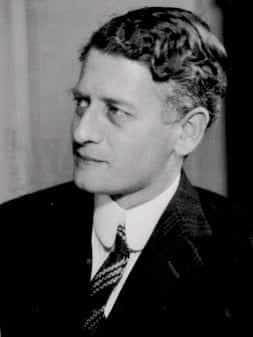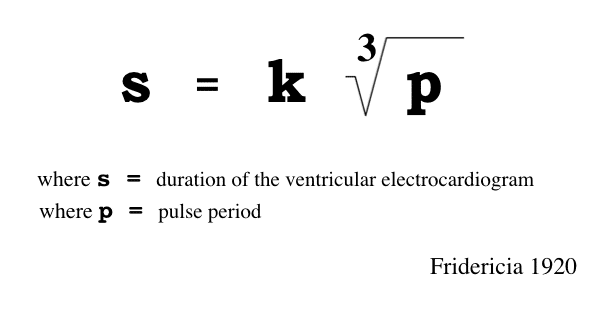Louis Fridericia

Louis Sigurd Fridericia (1881-1947) was a Danish physician.
In 1920 Fridericia found that the duration of the QT interval was related to the cube root of the RR interval (the Fridericia formula) – independent of the relationship defined by Bazett (1920) where he related the corrected QT interval to the square root of the RR interval (the Bazett formula)
Fridericia investigated the relationship between vitamin deficiency and night blindness in rats. He introduced the term ‘refection‘ following studies demonstrating rats could grow and thrive without ‘vitamin B’ in their diet. Refection enabled rats to make use of the vitamins synthesized in the caecum by ‘microbial agents’ activated in vitamin B deficiency
We propose to name this restoring change: refection (Latin: reficere = restore). To induce refection will be termed to refect: and agencies capable of refecting will be termed refectious
Fridericia LS, 1925
Biography
- Born on February 24, 1881 in Copenhagen, Denmark
- 1906 – Medical degree, University of Copenhagen
- 1907 – Assistant to Christian Bohr at the Physiological Laboratory, University of Copenhagen
- 1909 – Assistant to Carl Julius Salomonsen at the Institute of General Pathology, University of Copenhagen
- 1910 – Doctoral thesis – Undersøgelser over fosterstofskifte [Fetal metabolism studies]
- 1913-18 assistant physician at the Rigshospitalet, Kommunehospitalet and Bispebjerg Hospital with special interest in cardiology
- 1918 – Professor of hygiene, Hygienic Institute of the University of Copenhagen
- 1920 – Country Editor of the Nordic Hygiene Journal
- 1935 – President, Medical Society of Copenhagen
- 1943 – Escaped Nazi persecution in Denmark being smuggled in a fishing boat to Sweden and then to London
- Died on February 26, 1947
Medical Eponyms
Fridericia formula (1920)
Formula for calculating the QT interval on an electrocardiogram (ECG) according to heart rate. Using this formula, Fridericia postulated that QT values >0.43 seconds were considered prolonged
In 1920, Fridericia hypothesised a relationship between the duration of the ventricular electrocardiogram (s) and the duration of the pulse period (p). He studied 50 healthy individuals (age 3-81 years; 28 males and 32 females) at rest to determine the accuracy and the error rate in the measurement of both the pulse period (p) and the duration of the ventricular electrocardiogram (s).
He found that QT could be predicted accurately from the following formula: s = K (p0.3558) which he then simplified (p0.3558) to ³√p without any significant error; then calculated k (=8.22) for normal healthy individuals.

He concluded that in a normal, resting subject, the duration of electrical systole on an ECG is proportional to the cube root of the duration of the pulse period.

By applying this equation to his data set, Fridericia defined an average (Gauss) error of 0.015 seconds for a single duration. Variations of the observed duration of electrical systole >3 times the average error were considered to be pathological. Therefore the upper value for a ‘normal QT interval’ at a heart rate of 60 bpm was defined as 0.427 seconds (0.382 sec+0.045 s), and so QT values>0.43 seconds were deemed prolonged.
Major Publications
- Fridericia LS. Die Systolendauer im Elektrokardiogramm bei normalen Menschen und bei Herzkranken I: Beziehung zwischen der Pulsfrequenz und der Dauer des Ventrikelelektrokardiogramms bei normalen Menschen in der Ruhe [The Duration of Systole in an Electrocardiogram in Normal Humans and in Patients with Heart Disease. 1. Relationship of the pulse frequency and the duration of the ventricular electrocardiogram in normal humans at rest]. Acta Medica Scandinavica 1920; 53: 469–486 [Translated reprint: Ann Noninvasive Electrocardiol. 2003; 8(4): 343-351.]
- Fridericia LS, Holm E. Experimental Contribution to the Study of the Relation Between Night Blindness and Malnutrition. American Journal of Physiology, 1925; 73: 63-78
- Lund H, Spur B, Fridericia LS. Fridericia LS. The biological and titrimetric determination of vitamin C. Biochem J. 1934;28(5):1825-8.
- Fridericia LS, Freudenthal P, Gudjonnsson S, Johansen G, Schoubye N. Refection, a Transmissible Change in the Intestinal Content, enabling Rats to grow and thrive without Vitamin B in the Food. J Hyg (Lond). 1927; 27(1): 70-102
- Fridericia LS. Undersøgelser over fosterstofskifte. [Fetal metabolism studies] København, Høegh Vogelius, 1910
References
Biography
Personal communication: Danish biographical research and portrait: Louis Sigurd Fridericia. Flemming and Agnes Voss – Hørsholm, Denmark
- Norgaard A. LS Fridericia. Dansk Biografisk Leksikon on lex.dk
- Kon SK. Professor Dr Med. Louis Sigurd Fridericia. British Journal of Nutrition. 1947; 1(2): 111-112
- Todhunter EN. Biographical notes from the history of nutrition. Louis Sigurd Fridercia–February 24, 1881-February 26, 1947. J Am Diet Assoc. 1969; 55(4): 420
- Bibliography. Fridericia, LS. WorldCat Identities
Eponymous terms
- Moss AJ Introductory note to a translated classic article of L. S. Fridericia. Ann Noninvasive Electrocardiol. 2003;8(4): 341-342.
- Cadogan M. History of the Electrocardiogram. LITFL 2020
